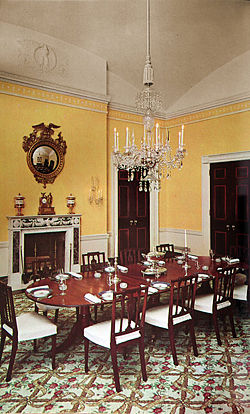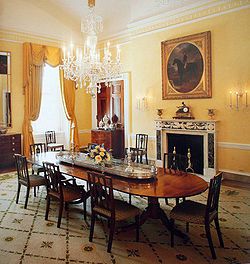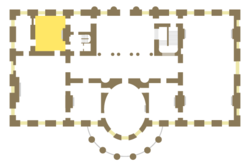- Family Dining Room (Maison Blanche)
-
 La salle à manger familiale durant le mandat de John F. Kennedy. La salle reste peu changée depuis sa redécoration par Sister Parish pour les Kennedy.
La salle à manger familiale durant le mandat de John F. Kennedy. La salle reste peu changée depuis sa redécoration par Sister Parish pour les Kennedy.
La Salle à manger familiale (Family Dining Room) est située au premier étage (appelé State Floor) de la Maison Blanche, la résidence officielle du président des États-Unis. Cette salle est utilisée pour les repas plus privés que ceux servis dans la Salle à manger d'État (appelée State Dining Room). Aujourd'hui, le président utilise moins la salle à manger familiale pour la famille mais plus pour les repas d'affaire et les petits dîners. Les dîners familiaux sont plus souvent servis au deuxième étage, dans la salle à manger du président (appelée President's Dining Room).
Peu après la construction de la Maison Blanche, un besoin s'est fait ressentir pour une salle à manger privée. Thomas Jefferson utilisait l'actuelle Green Room (Sallon vert) comme sa salle à manger privée. Les nouveaux plans pour la reconstruction de la Maison Blanche après l'Incendie de Washington en 1814 indiquait une Salle à manger d'État au sud ouest et une salle à manger privée au nord ouest du premier étage. Dans la dernière moitié du 19e siècle, un garde-manger a été ajouté au nord ouest, réduisant la taille de la salle à manger privée, et le terme de "Salle à manger familiale" commença à remplacer le nom de "Salle à manger privée".
Sommaire
McKim's neoclassical redesign
Renovations by architect Charles Follen McKim during the administration of Theodore Roosevelt architecturally transformed the Family Dining Room. Using White House architect James Hoban's groin vaulted ground floor hall ceilings as a model, McKim installed a similar groin vault ceiling. The surface was articulated with a low relief plaster meander (Greek key) and five-pointed star decoration, and an eagle within a laurel wreath on the east wall above the mantel. McKim commissioned the Boston furniture manufacturer A.H. Davenport to build a somewhat overscaled Federal-style sideboard and china cabinet, and dining table. Reproduction Chippendale-style sidechairs replaced the series of Victorian chairs used in the nineteenth century.
The Truman reconstruction
A photograph of the ceiling area taken while the room was being dismantled previous to the Truman reconstruction, shows the simple c. 1818 moulding and several pieces of Victorian era wall paper. Plaster decoration and wood trim was removed from the room with the intention of reinstalling it after the reconstruction. Like much of the salvaged wood and plaster from the house, it was pronounced unusable. McKim's groin vaulted ceiling and plaster decoration was copied, along with the Greek key, stars and large eagle ornament. Most of McKim's Colonial Revival furniture was returned to the room.
Kennedy restoration and later administrations
During the Kennedy restoration the room was designed largely by Sister Parish who asked preservation architect Robert Raley, a consulting architect to Henry Francis DuPont's Winterthur Museum, to assess the room. Raley considered the room to be very strong and in keeping with the White House's time of construction. He made two proposals which were followed: the removal of moulding that organized the walls into a series of upper and lower panels; and the lowering of the window height by extending a cornice across the north wall of the room. These changes had the dual effect of unifying the room and giving the vaulted ceiling more presence.
Parish had the walls painted a soft yellow, and yellow silk curtains, tied back twice with ornamental cords and tassels, installed within the frame of the windows. French interior designer Stéphane Boudin had recommended a similar treatment by her in the Yellow Oval Room. A series of mantels and chandeliers were tried, finally resulting in permanent installation of a late Louis XVI green marble mantelpiece with a carved eagle and festoons in white marble. this mantel was acquired for the Yellow Oval Room but proved too small for the scale of that room. Baseboard trim was faux painted to match the green marble of the mantel. A Federal period dining and side chairs have been used since.
Today the room appears little changed since the Kennedy restoration. Yellow silk drapery based on an English Regency pattern have been installed and cover the window frames. They were designed in 1981 by Ted Graber, under First Lady Nancy Reagan's supervision. She also approved new upholstery for the chair and a new carpet for the room. A silver mirror plateau, made in New York by John W. Forbes, c. 1820 sits on the table.
References and further reading
- Abbott James A., and Elaine M. Rice. Designing Camelot: The Kennedy White House Restoration. Van Nostrand Reinhold: 1998. ISBN 0-442-02532-7.
- Garrett, Wendell. Our Changing White House. Northeastern University Press: 1995. ISBN 1-55553-222-5.
- McKellar, Kenneth, Douglas W. Orr, Edward Martin, et al. Report of the Commission on the Renovation of the Executive Mansion. Commission on the Renovation of the Executive Mansion, Government Printing Office: 1952.
- Monkman, Betty C. The White House: The Historic Furnishing & First Families. Abbeville Press: 2000. ISBN 0-7892-0624-2.
- Seale, William. The President's House. White House Historical Association and the National Geographic Society: 1986. ISBN 0-912308-28-1.
- Seale, William, The White House: The History of an American Idea. White House Historical Association: 1992, 2001. ISBN 0-912308-85-0.
- The White House: An Historic Guide. White House Historical Association and the National Geographic Society: 2001. ISBN 0-912308-79-6.
Modèle:White House
Wikimedia Foundation. 2010.


